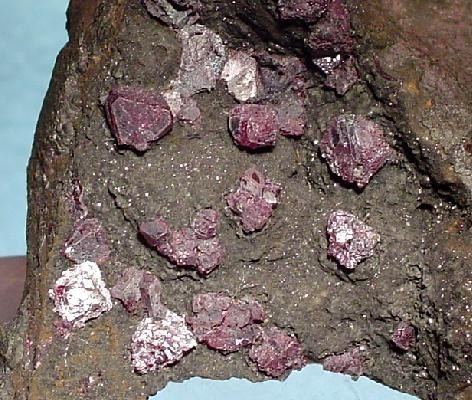Category Oxide minerals Strunz classification 4.AB.15 Space group R3m | Formula(repeating unit) CuFeO2 Crystal system Trigonal | |
 | ||
Crystal class Hexagonal scalenohedral (3m)H-M symbol: (3 2/m) | ||
Delafossite is a copper iron oxide mineral with formula CuFeO2 or Cu1+Fe3+O2. It is member of the delafossite mineral group with a general formula ABO2, a group characterized by a sheet of linearly coordinated A cations stacked between edge-shared octahedral layers (BO6). Delafossite along with other minerals of the ABO2 group has been recognized for its electrical properties from insulation to metallic conduction. Delafossite is usually a secondary mineral that crystallizes near oxidized copper and is rarely a primary mineral.
Contents
Composition
The chemical formula for delafossite is CuFeO2 and was determined through chemical analysis of the pure mineral by G. S. Bohart of the Chemistry Department of Stanford University. The ratio given was very close to Cu:Fe:O=1:1:2 with a slightly more iron than copper. Rogers. attributed this fact to a small amount of hematite in the sample. In order to determine the composition of delafossite Rogers used the Ziervogel process. The Ziervogel process is used to test for the presence of cuprous oxides by looking for the "spangle reaction" which produces thin flakes of metallic silver when cuprous oxide is mixed with silver sulfate. When Rogers heated powdered delafossite with silver sulfate solution, the spangle reaction occurred. The only oxides possibilities to consider for delafossite are cuprous copper and ferrous iron. Rogers concluded that the iron was combining with the oxygen as a radical and that it only acted as a radical. This indicated that the copper in delafossite was in the cuprous rather than the cupric form. Hence he concluded that the composition of delafossite was probably cuprous metaferrite, CuFe3+O2. This composition was later confirmed by Pabst by the determination of interionic distances in the crystal lattice.
Structure
The atomic structure of delafossite and the delafossite group consists of a sheet of linearly coordinated A cations stacked between edge-shared octahedral layers (BO6). In the delafossite atomic structure there are two alternating planar layers. The two layers consist of one layer triangular-patterned A cations and a layer of edge-sharing BO6 octahedra compacted with respect to the c-axis. The delafossite structure can have two polytypes according to the orientation of the planar layer stacking. Hexagonal 2H types that have a space group of P63/mmc are formed when two A layers are stacked with each layer rotated 180° in relation to one another. Alternatively, when the layers are stacked each layer in the same direction in relation to one another, it makes a rhombohedral 3R type with a space group of R3m.
Physical properties
The color of delafossite is black, with a hardness of 5.5, and imperfect cleavage in the {1011} direction. Pabst calculated the density of delafossite to be 5.52. Contact twinning has been observed in the {0001} direction. The unit cell parameters were calculated to be a = 3.0351 Å, c = 17.166 Å, V = 136.94 Å3. Delafossite is tabular to equidimensional in habit and has a black streak and a metallic luster. Delafossite has hexagonal symmetry that can have the space groups R3m or P63/mmc depending on the stacking of A cation layers. Delafossite compounds can have magnetic properties when magnetic ions are in the B cation position. Delafossite compounds also have properties dealing with electric conductivity such as insulation and/or metallic conduction. Delafossite compounds can exhibit p- or n-type conductivity based on their composition.
Rhombohedral (3R), CuFeO2 properties
P-type semiconductor, bandgap 1.47 eV High light absorption coefficient of 7.5 × 104 cm–1 near the band gap edge at 700 nm. High hole mobility of 34 cm2 v−1 s−1 even at doping levels as high as 1.8 × 1019 cm−3. Good stability in aqueous environments.
Hexagonal (2H), CuFeO2 properties
properties, unknown Pure 2H CuFeO2 are very difficult to synthesize.
Synthesis
3R CuFeO2 is often synthesized by solid state reactions, Sol gel methods, and Hydrothermal synthesis.
Pure 2H CuFeO2 and other 2H delafossite-type oxides are difficult to synthesize. The only pure 2H CuFeO2 crystals were pure 2H CuFeO2 nanoplates with a thickness of about 100 nm were synthesized at temperatures as low as 100 °C from CuI and FeCl3·6H2O.
solar cell
2H CuFeO2 has 1.33 eV band gap and high absorption coefficient of 3.8 × 104 cm−1 near the band gap edge at 700 nm. It demonstrated a photovoltaic effect when placed into thin film structures composed of ITO/ZnO/2H CuFeO2/graphite/carbon black.
other applications
CuFeO2 is made of earth abundant elements and has good stability in aqueous environments8, and as such was investigated as photocathodes for photoelectrochemical reduction of CO2, solar water reduction, and as a cathode material in Li batteries. Whereas 3R phase was somewhat characterized, only X-ray diffraction and theoretical calculation of eg and t2g occupancies of the Fe3+ are available for 2H CuFeO2.
Geologic occurrence
In 1873, delafossite was discovered by Charles Friedel in a region of Ekaterinbug, Siberia. Since its discovery it has been identified as a fairly common mineral found in such places as the copper mines of in Bisbee, Arizona. Delafossite is usually a secondary mineral often found in oxidized areas of copper deposits although it can be a primary mineral as well. Delafossite can be found as massive, relatively distinct crystals on hematite. Delafossite has since been found in mines around the world from Germany to Chile.
Origin of the name
Delafossite was first noted by Charles Friedel in 1873 and given the composition Cu2O.Fe2O3. The mineral was given the name delafossite in honor of the French mineralogist and crystallographer Gabriel Delafosse (1796–1878). Delafosse is known for noting the close relationship between crystal symmetry and physical properties.
